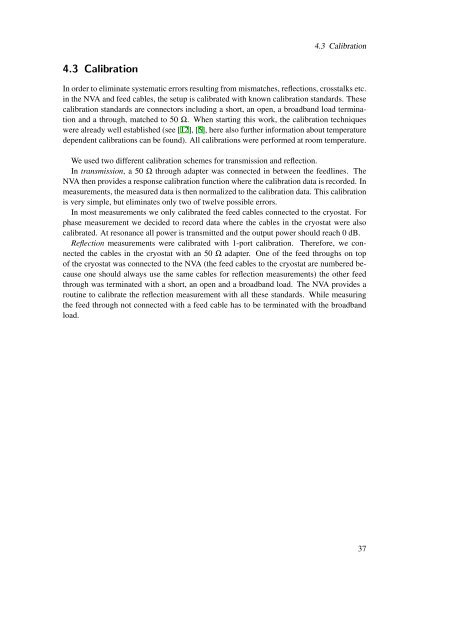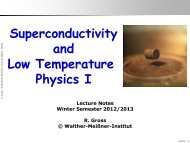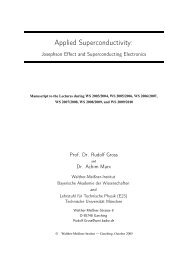Design, Fabrication and Characterization of a Microwave Resonator ...
Design, Fabrication and Characterization of a Microwave Resonator ...
Design, Fabrication and Characterization of a Microwave Resonator ...
Create successful ePaper yourself
Turn your PDF publications into a flip-book with our unique Google optimized e-Paper software.
4.3 Calibration4.3 CalibrationIn order to eliminate systematic errors resulting from mismatches, reflections, crosstalks etc.in the NVA <strong>and</strong> feed cables, the setup is calibrated with known calibration st<strong>and</strong>ards. Thesecalibration st<strong>and</strong>ards are connectors including a short, an open, a broadb<strong>and</strong> load termination<strong>and</strong> a through, matched to 50 Ω. When starting this work, the calibration techniqueswere already well established (see [12], [5], here also further information about temperaturedependent calibrations can be found). All calibrations were performed at room temperature.We used two different calibration schemes for transmission <strong>and</strong> reflection.In transmission, a 50 Ω through adapter was connected in between the feedlines. TheNVA then provides a response calibration function where the calibration data is recorded. Inmeasurements, the measured data is then normalized to the calibration data. This calibrationis very simple, but eliminates only two <strong>of</strong> twelve possible errors.In most measurements we only calibrated the feed cables connected to the cryostat. Forphase measurement we decided to record data where the cables in the cryostat were alsocalibrated. At resonance all power is transmitted <strong>and</strong> the output power should reach 0 dB.Reflection measurements were calibrated with 1-port calibration. Therefore, we connectedthe cables in the cryostat with an 50 Ω adapter. One <strong>of</strong> the feed throughs on top<strong>of</strong> the cryostat was connected to the NVA (the feed cables to the cryostat are numbered becauseone should always use the same cables for reflection measurements) the other feedthrough was terminated with a short, an open <strong>and</strong> a broadb<strong>and</strong> load. The NVA provides aroutine to calibrate the reflection measurement with all these st<strong>and</strong>ards. While measuringthe feed through not connected with a feed cable has to be terminated with the broadb<strong>and</strong>load.37
















